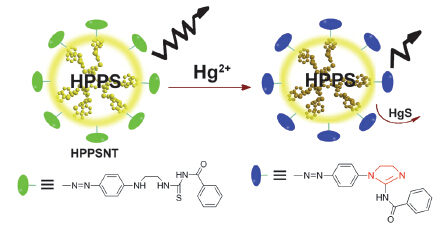| [1] Ma, X.; Song, F.; Wang, L.; Cheng, Y.; Zhu, C. J. Polym. Sci. Polym. Chem. 2012, 50, 517.
[2] Nolan, E. M.; Lippard, S. J. Acc. Chem. Res. 2009, 42, 193.
[3] Mancin, F.; Rampazzo, E.; Tecilla, P.; Tonellato, U. Chem. Eur. J. 2006, 12, 1884.
[4] Liu, B.; Tian, H. Chem. Commun. 2005, 3156.
[5] Yang, Y. K.; Yook, K. J.; Tae, J. J. Am. Chem. Soc. 2005, 127, 16760.
[6] Zhu, M.; Yuan, M.; Liu, X.; Xu, J.; Lv, J.; Huang, C.; Liu, H.; Li, Y.; Wang, S.; Zhu, D. Org. Lett. 2008, 10, 1481.
[7] Niu, H. T.; Su, D.; Jiang, X.; Yang, W.; Yin, Z.; He, J.; Cheng, J. P. Org. Biomol. Chem. 2008, 6, 3038.
[8] Zhang, Y.; Li, W.; Wang, Q.; Zhang, R.; Xiong, Q.; Shen, X.; Guo, J.; Chen, X. Acta Chim. Sinica 2013, 71, 1496. (张勇, 李伟, 王强, 张若璇, 熊启杰, 沈祥, 郭靖, 陈雪梅, 化学学报, 2013, 71, 1496.)
[9] Adhikari, B.; Majumdar, S. Prog. Polym. Sci. 2004, 29, 699.
[10] Haupt, K.; Klaus, M. Chem. Rev. 2000, 100, 2495.
[11] Jiang, T.; Jiang, G.; Wang, X.; Dong, Y.; Wei, Z.; Li, X.; Tang, B. Des. Monomers. Polym. 2014, 17, 576.
[12] Wu, X.; Xu, B.; Tong, H.; Wang, L. Macromolecules 2011, 44, 4241.
[13] Feng, J.; Li, Y.; Yang, M. J. Polym. Sci. Polym. Chem. 2009, 47, 222.
[14] Mellace, A.; Hanson, J. E.; Griepenburg, J. Chem. Mater. 2005, 17, 1812.
[15] Lee, M. H.; Cho, B.-K.; Yoon, J.; Kim, J. S. Org. Lett. 2007, 9, 4515.
[16] Xu, R.; Liu, H.; Shi, W. J. Polym. Sci. Polym. Phys. 2006, 44, 826."" |
